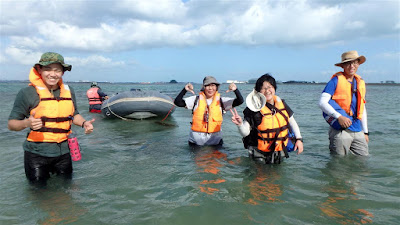Two weeks ago, a team of us visited Semakau East via amphibious landing. As we arrived early, we landed on the reef while the waters are still high.
Carefully, everyone walked towards rocks that protrude out of the water surface. As it was windy, the ripples on the water surface didn't help us to see clearly where we are stepping on.
As the tide seem to be taking longer than usual to go out, some of us decide to just look around the area. There's this disused pipe-looking structure and there are some marine life inside.
I saw a big blob within the structure and it was a huge Forskal's sidegill slug (Pleurobranchus forskalii).
My original grand plan for this trip is to start at one location and end with another so that we can cover ground. However, that also meant we now have to wade through high waters towards the destination. It was only where we were closer to the seawall that we could properly explore the reef.
For some reason, there were quite a number of these Very long ribbon worms (Baseodiscus delineatus). Despite looking softy and harmless, ribbon worms are fierce predators. They have a unique eversible proboscis that can wound around the prey which is then hauled back toward the worm's mouth. After which, sticky mucus is secreted to help grip the prey.
There were several clumps of Acropora corals (Acropora sp.) on the reef. Though some of them are green and pink. Not too sure if it's a sign of stress.
The Button zoanthids (Zoanthus sp.) look really pretty in close up. They are like tiny sea anemones with long bodies. Some species of zoanthids may be highly toxic so don't touch them!
Jonathan found this unidentified clam with horizontal lines across the shell.
A beautiful Blue dragon nudibranch (Pteraeolidia ianthina) was sighted! This nudibranch has finger-like projections (cerata) arranged in hand-like clusters along the length of the body.
The team also found this juvenile swimming crab which we are unsure if it is the young of the common ones we see or belong to another species altogether.
What is this bizzare looking creature? It is not an anemone but an Upsidedown jellyfish (Cassiopea sp.). It prefers to be 'upside down', with its bell facing the sea floor and tentacles facing upwards toward the light. This is because they harbour microalgae on their tentacles, thus they need to be upside down to make food.
This Fire anemone (Actinodendron sp.) is not too obvious as it has tucked in its tentacles as the tide went out.
There are quite a number of interesting critters underneath rocks. I saw two of the juvenile Three stripe flatworms (Pseudoceros tristriatus) as a result of flipping rocks below the seawall.
Another find from rock flipping would be this Gymnodoris nudibranch (Gymnodoris sp.).
We ended the trip with yet another splashing good time as the wind blew splashes of sea wall as we made our way back to the main boat using the dinghy. Those seated in front were almost completely wet.What an exciting trip we had! Wild and wet!




















No comments:
Post a Comment